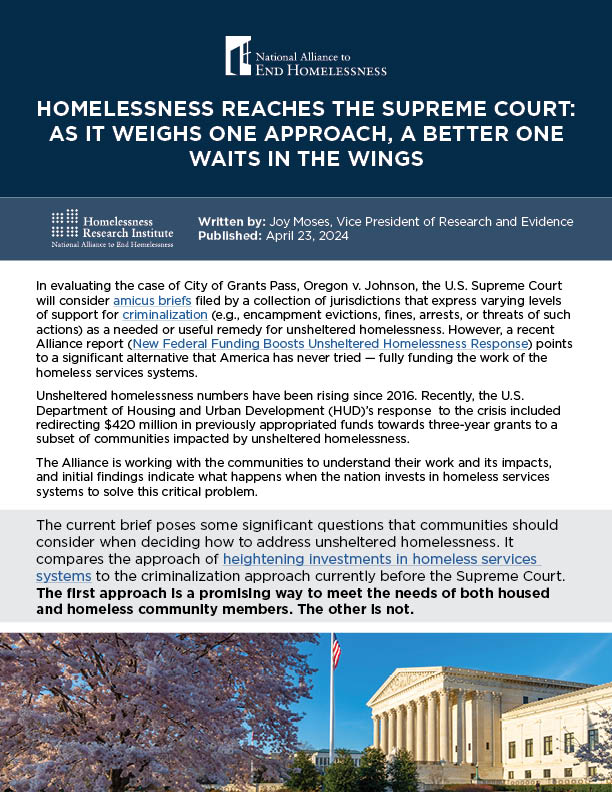Written by: Joy Moses, Vice President of Research and Evidence
In evaluating the case of City of Grants Pass, Oregon v. Johnson, the U.S. Supreme Court will consider amicus briefs filed by a collection of jurisdictions that express varying levels of support for criminalization (e.g., encampment evictions, fines, arrests, or threats of such actions) as a needed or useful remedy for unsheltered homelessness. However, a recent Alliance report (New Federal Funding Boosts Unsheltered Homelessness Response) points to a significant alternative that America has never tried — fully funding the work of the homeless services systems.
Unsheltered homelessness numbers have been rising since 2016. Recently, the U.S. Department of Housing and Urban Development (HUD)’s response to the crisis included redirecting $420 million in previously appropriated funds towards three-year grants to a subset of communities impacted by unsheltered homelessness.
The Alliance is working with the communities to understand their work and its impacts, and initial findings indicate what happens when the nation invests in homeless services systems to solve this critical problem.
Click the boxes below to see the impact of
Investing in Homeless Services or Criminalization.
Question 1: What type of mission should drive efforts to reduce the number of people visibly living outside?
Action: When communities were granted new resources, they chose to direct 69 percent of the funds towards housing and services that help people maintain housing (e.g., case management). Most of the remaining dollars went towards street outreach and other supports that help people while they’re still homeless.
This approach results in people no longer being unsheltered in public.
Action: In cities like Los Angeles and San Francisco encampment evictions forced people to leave targeted locations… but most remain unsheltered and encampments often return (because people have no place to go). L.A.’s encampments response was said to be a “complete and total failure.” Other cities have had similar results.
This approach results in people continuing to be unsheltered in public spaces.
Question 2: Who should be responsible for making decisions and doing the work of addressing this challenge?
- Homeless services providers
- Mental and physical healthcare providers
- Housing search and public benefits experts
- People who experienced homelessness and identified ways to exit those circumstances.
The people who are most equipped for and experienced in this work are the ones who should be leading it.
As first responders, law enforcement officers often encounter many other issues. However, they are typically not required to be experts on homelessness, poverty, mental health, or other issues tied to living unsheltered. Significant voices in the law enforcement community say they are not equipped for this work, and their involvement increases the potential for violent encounters while distracting them significant threats to public safety or “activities that matter the most”.
Question 3: What process should communities use for deciding how to respond to homelessness?
- Analyzed local homelessness data.
- Engaged community members.
- Created a comprehensive strategy for unsheltered people.
- Committed to partnerships with housing and healthcare providers.
After engaging in this process, local homelessness experts demonstrated a clear, data-driven foundation to move forward with their approaches to unsheltered homelessness.
In response to these pressures, local leaders take action. They often prioritize action over consulting strategies that will improve homelessness in the long term. Local leaders will decide to move people out of a targeted area because a reporter chose to talk about it, or the people in that neighborhood are particularly loud or socially or economically powerful.
Question 4: How does existing research inform types of homelessness response?
Additionally, communities reported investing in plans to both scale up previously tested strategies and pilot new innovative approaches.
Further, there is no evidence that criminalization reduces citizen complaint calls, or that public safety increases as a result.
Question 5: How can communities determine who they target their focus and resources on?
With enough dollars, communities can sustain and expand this work to reach all unsheltered people in all neighborhoods.
Well-resourced street outreach offers aid — connecting people to such items as food, health services, housing search help, or shelter.
Criminalization imposes measures such as displacement, property seizures, fines, and incarceration on people experiencing homelessness.
Social scientists point to research that says these measures worsen a person’s health, perpetuate poverty, and cause a list of other harms.
Meanwhile, America has never fully funded its homeless services systems. Although able to expand their work, none of the 24 communities interviewed by the Alliance believed that their grant was enough to end unsheltered homelessness. One indicated that they received $5 million for a problem that is estimated to cost more than $1 billion to solve. The Supreme Court will be weighing arguments this summer, but other significant battles must be waged in Congress, state capitols, and city halls to pay the rest of the tab for homeless services and getting people into housing.

